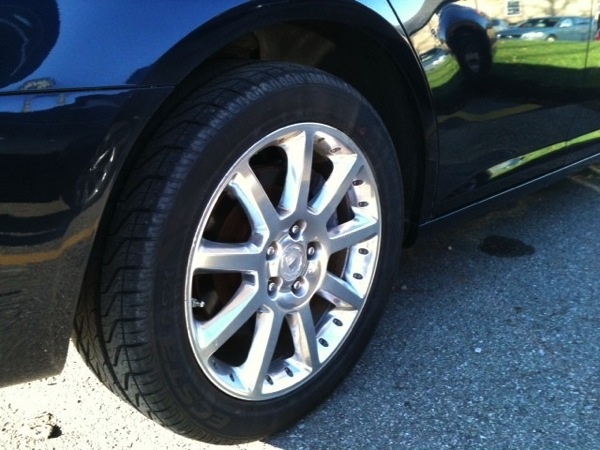Uh oh. Wasn’t there a deceptively deep pothole you hit the other day? Is your car now tending to pull or drift to the left or right? Or maybe there’s too much “play” in the steering? By diagnosing any tire problems, the candor and castor of your front-end alignment, and taking it for a road test, any questions can be easily answered. And then you can move onto How to Fix the Alignment on a Car!
Steps
1. Eliminate tire problems. Before attempting to diagnose a front end alignment problem, you need to be sure your tires are not causing steering problems you may be experiencing.
Check the air pressure on all four tires, making sure to inflate them to the recommended pressure. You should find the manufacturer’s recommended inflation pressure on the label attached to the driver’s side door.
Check to see that the tread (or tire pattern) and tire size are the same on both front wheels. You do not want to have a mud and snow tire on one side and a normal highway tire on the other side. This, or any combination of different tire types or sizes, can cause the car to pull one way or the other.
Check to see it the tires are showing unusual wear or are damaged. Look over the tire completely. Does it look symmetrical, round? Are there chunks missing from the tread? Carefully feel around the tire with your hand to see if there are deformities or bulges, indicating the tread is trying to separate from the steel belts.
2. Examine your front-end alignment. There are different aspects to front end alignments for rear wheel drive vehicles. You may observe serious alignment problems with a tape measure and a two foot level by checking them. These are:
Toe-in. The front of each tire, when driving straight, points slightly to the centerline of the vehicle. This gives an advantage when cornering so each tire has equal traction (bite), but if it is angled inward (positive) too much, the OUTSIDE of the tire’s tread wears more quickly. Measure the front and rear distances between the centerline of the tires will give you an idea of how much toe-in your vehicle has.
Castor. This is the vertices angle of the centerline of the tire from front to back. This angle is best checked with an automotive shop’s front end equipment, but unless the ball joints, control arm bushings, or king pins are seriously worn, the castor doesn’t vary too much.
Camber. This is the vertical angle of the centerline of the tire perpendicular to the cross-section of your car. You can park your car on a level surface, and using a two foot builder’s (spirit) level to check to see if they are plumb.
3. Road test your vehicle. Drive on a flat, level, smooth highway and do the following tests.
Let your grip on the steering wheel loosen enough to let the car proceed on its own while driving down a fairly straight road on a day when the weather is dry and the wind calm. You may need an alignment if the car pulls to the left or right.
Check the sounds from the front end of the car, driving slowly listen for scraping, whining, or grinding sounds. These may indicate excessive friction as the tire tread rubs against the road, or other problems.
Have someone follow you at a moderate speed to observe the front to back wheel alignment. If the front wheels are not tracking in the same groove as the back, you may have a bent frame.
Drive the car in a weaving pattern in an empty parking lot while someone observes the wheels. They may notice unusual leaning in the tires, or hear wheel bearings making noises indicating problems.
3Road test your vehicle. Drive on a flat, level, smooth highway and do the following tests.
Let your grip on the steering wheel loosen enough to let the car proceed on its own while driving down a fairly straight road on a day when the weather is dry and the wind calm. You may need an alignment if the car pulls to the left or right.
4. Check the sounds from the front end of the car, driving slowly listen for scraping, whining, or grinding sounds. These may indicate excessive friction as the tire tread rubs against the road, or other problems.
Have someone follow you at a moderate speed to observe the front to back wheel alignment. If the front wheels are not tracking in the same groove as the back, you may have a bent frame.
Drive the car in a weaving pattern in an empty parking lot while someone observes the wheels. They may notice unusual leaning in the tires, or hear wheel bearings making noises indicating problems.
5. Have your front end checked and realigned and repeat the tests to make sure it has been done correctly.
6. Finished.
Whether working on cars is a hobby or a cost-driven necessity, most DIYers and backyard mechanics are better off with inexpensive alternatives to expensive professional tools. There are some good tools that can interface with your computer, phone, or tablet.

How to Diagnose an Alignment Problem
by
Tags:

Leave a Reply